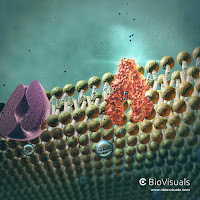Changing the Paradigm of CF Healthcare
 |
| CRISPR Cas9 Cutting targeted area of DNA |
Research in gene editing has begun to demonstrate the possibility of replacing mutated genes through the use of CRISPR-Cas9, which uses a single stranded RNA to guide a nuclease to remove mutated genes in the genome. The CRISPR-Cas9 system holds potential in the development of gene therapies for genetic diseases like cystic fibrosis.
 |
| CFTR Gene modifies the channels preventing choloride passage |
Briefly, cystic fibrosis is a genetically inherited disease that results from mutations in the cystic fibrosis transmembrane conductance regulator (CFTR) gene. The CFTR gene produces a protein in the cell that functions as a chloride channel in epithelial cells, which line passages in organs throughout the body. Mutations in this gene affect the protein by either reducing the quantity that makes it to the cell membrane, preventing the proper function of the protein on the cell membrane, or both. The resulting dysfunction creates dehydrated mucous in organs, specifically in the lung, which can lead to chronic lung infections, decreased lung function and end stage lung disease.
Therapies to address the underlying cause of CF can be directed to one of three levels in the cell: DNA, RNA, or protein. DNA, which is housed in the nucleus of the cell, contains the necessary instructions to create all the required proteins. The DNA, however, is not free to roam outside of the nucleus and, therefore, the instructions contained in DNA are transcribed or copied into RNA, which travels out of the nucleus where the directions are read to create the necessary protein. Proteins then are the final stage and are pivotal in providing the vital functions for maintaining cell survival.

Comments
Post a Comment